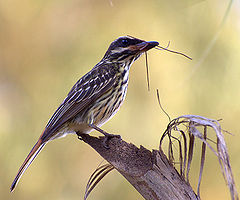- Streaked Flycatcher
-
Streaked Flycatcher 
In Sarutaiá (São Paulo state, Brazil) Conservation status Scientific classification Kingdom: Animalia Phylum: Chordata Class: Aves Order: Passeriformes Family: Tyrannidae Genus: Myiodynastes Species: M. maculatus Binomial name Myiodynastes maculatus
(Statius Muller, 1776)The Streaked Flycatcher, Myiodynastes maculatus, is a passerine bird in the tyrant flycatcher family. It breeds from eastern Mexico, Trinidad and Tobago south to Bolivia and Argentina. The southern subspecies M. m. solitarius migrates to Venezuela and the Guianas from March to September during the austral winter.
The Streaked Flycatcher is 22 cm long, weighs 43g and has a strong black bill. The head is brown with a concealed yellow crown patch, white supercilium and dusky eye mask. The upperparts are brown with darker brown streaks on the back, rufous and white edges on the wings, and wide chestnut edges on the rump and tail. The underparts are yellowish-white streaked with brown.
Sexes are similar, but immature birds are brown where the adult is black. M. m. solitarius has black rather than brown streaking above and below. The Streaked Flycatcher is a conspicuous bird, with a noisy sqEEE-zip call.
This species is found at the edges of forests and cocoa plantations. Streaked Flycatchers eat a range of food items, mostly large insects, but also lizards and berries. It perches on a high watchpoint from which it sallies forth to catch insects in mid-flight or off plants using a range of aerobatic maneuvers, and occasionally gleans prey from the vegetation.[1] The wintering southern migrants seem to include a considerable amount of fruit in their diet, for example those of Tamanqueiro (Alchornea glandulosa) which they sometimes eat in quantity; fruit are typically ripped off in mid-hover.[2] It occasionally follows mixed-species feeding flocks, pouncing from up in the trees on prey flushed by birds in the undergrowth.[3]
The nest is an open cup of twigs and grasses placed in a tree hollow or sometimes a bromeliad. The female builds the nest and incubates the typical clutch of two or three creamy-white eggs, which are marked with red-brown spots, for 16–17 days to hatching. Both sexes feed the chicks, which fledge in a further 18–21 days.
Common across its wide range, this species is not considered threatened by the IUCN.[4]
Footnotes
References
- BirdLife International (BLI) (2008). Myiodynastes maculatus. In: IUCN 2008. IUCN Red List of Threatened Species. Downloaded on 16 November 2008.
- de A. Gabriel, Vagner & Pizo, Marco A. (2005): Foraging behavior of tyrant flycatchers (Aves, Tyrannidae) in Brazil. Revista Brasileira de Zoologia 22(4): 1072–1077 [English with Portuguese abstract]. doi:10.1590/S0101-81752005000400036 PDF fulltext
- ffrench, Richard; O'Neill, John Patton & Eckelberry, Don R. (1991): A guide to the birds of Trinidad and Tobago (2nd edition). Comstock Publishing, Ithaca, N.Y.. ISBN 0-8014-9792-2
- Hilty, Steven L. (2003): Birds of Venezuela. Christopher Helm, London. ISBN 0-7136-6418-5
- Machado, C.G. (1999): A composição dos bandos mistos de aves na Mata Atlântica da Serra de Paranapiacaba, no sudeste brasileiro [Mixed flocks of birds in Atlantic Rain Forest in Serra de Paranapiacaba, southeastern Brazil]. Revista Brasileira de Biologia 59(1): 75-85 [Portuguese with English abstract]. doi:10.1590/S0034-71081999000100010 PDF fulltext* Pascotto, Márcia Cristina (2006): Avifauna dispersora de sementes de Alchornea glandulosa (Euphorbiaceae) em uma área de mata ciliar no estado de São Paulo [Seed dispersal of Alchornea glandulosa (Euphorbiaceae) by birds in a gallery forest in São Paulo, southeastern Brazil.]. Revista Brasileira de Ornitologia 14(3): 291-296 [Portuguese with English abstract]. PDF fulltext
External links
- Streaked Flycatcher videos on the Internet Bird Collection
- Streaked Flycatcher photo gallery VIREO Photo-High Res
- Photo-High Res; Article www.ib.usp.br—"Tyrannidae"
- Photo-High Res--(Close-up); Article pbase.com–"Birds of Panama"
Categories:- IUCN Red List least concern species
- Myiodynastes
- Tyrannidae
- Birds of South America
- Birds of the Amazon Basin
- Birds of the Guianas
- Birds of Marajó Island
- Birds of the Cerrado
- Birds of the Caatinga
- Birds of the Pantanal
- Birds of Central America
- Birds of Mexico
- Birds of the Yucatán Peninsula region
- Native birds of Eastern Mexico
- South American migratory birds
Wikimedia Foundation. 2010.

